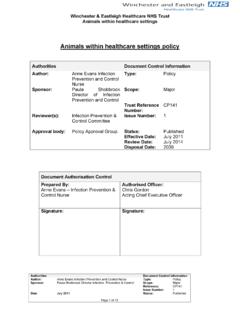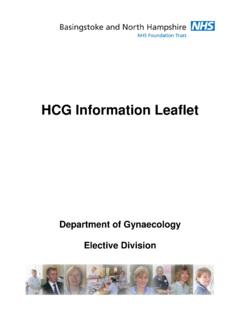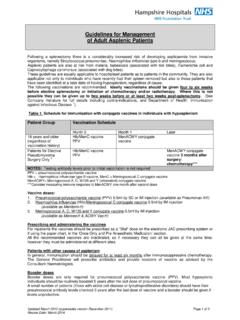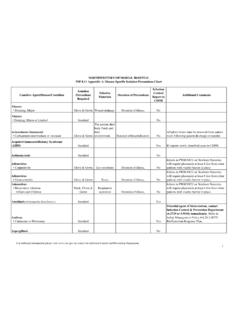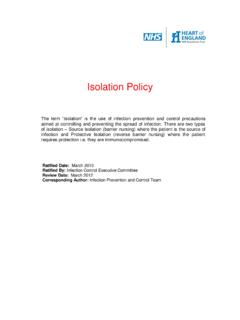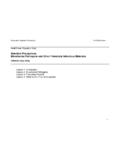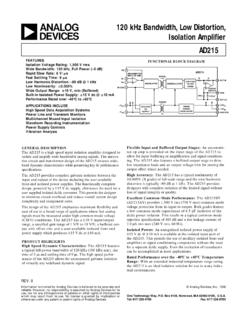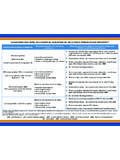Transcription of Isolation precautions for patients with confirmed …
1 IC/278/10 Isolation precautions for patients with confirmed or suspected infectious illness Page 1 of 37 BASINGSTOKE AND NORTH HAMPSHIRE NHS FOUNDATION TRUST Isolation precautions for patients with confirmed or suspected infectious illness IC/278/10 Supersedes: IC/278/07 Owner Name Hazel Gray Job Title Senior Infection Control Nurse Final approval committee Name Infection Control Committee Date of meeting 23 July 2010 Authoriser Name Dr Nicki Hutchinson Job title Director Infection Prevention and Control Signature Date of authorisation Review date (maximum 3 years from date of authorisation) July 2013 Audience (tick all that apply) Trust staff NHS General public Standards Standards for Better Health NHSLA The Health and Social Care Act 2008 Executive Summary It is important to minimise the risk of the spread of infection between patients .
2 This policy outlines the measures which should be taken to prevent the spread of infection from patients who are known to be a potential source of infection. Reviewed in accordance with The Health and Social Care Act 2008: Code of Practice for health and adult social care on the prevention and control of infections and related guidance published 16 December 2009 IC/278/10 Isolation precautions for patients with confirmed or suspected infectious illness Page 2 of 37 Implementation Plan Summary of changes Contact number changes Isolation sign changes Roles and responsibility Education Evaluation of policy Standard precautions update Action needed and owner of action All staff need to be aware of which patients may need isolating and what type of Isolation is necessary All staff need to be aware of the role they play in trying to reduce the spread of infection All staff need to adhere to this policy The Infection prevention and control team IPCT will evaluate policy when required The IPCT will monitor infection rates via
3 Alert organism surveillance IC/278/10 Isolation precautions for patients with confirmed or suspected infectious illness Page 3 of 37 Contents: Page Summary 4 Roles and Responsibilities 4 Education and training 5 Evaluation of this policy 5 Introduction 5 Policy Objectives 5 Categories of Isolation 6 Ring fencing 6 Source Isolation 6 Protective Isolation 6 Source Isolation 7 Patient placement 7 Preparation of the Isolation room 8 Hand Decontamination 8 What if you have cuts and breaks in your skin?
4 9 Hand hygiene - patient 9 Gloves 9 Aprons and gowns 9 Masks, face shields or eye protection 10 Patient care equipment 10 Environmental cleaning 10 Linen 10 Sharps Management 10 Crockery/cutlery 11 Bathing 11 Transport of infected patients 12 Visitors/ patients /carers 12 References and further reading 12 Appendix 1: Diarrhoea and/or Vomiting Risk Assessment Algorithm 13 Appendix 2: Respiratory Risk Assessment 14 Appendix 3: Skin Infection Risk Assessment Algorithm 14 Appendix 4: Isolation Priorities 16 Appendix 5: Risk Assessment using the Isolation Priority Scoring System 17 Appendix 6: Priority Scoring System: Infectious Diarrhoea 18 Appendix 7: Priority Scoring System: MRSA 19 Appendix 8: Priority Scoring System: Antimicrobial-Resistant Bacteria 20 Appendix 9: Priority Scoring System: Respiratory Infections 21 Appendix 10: Priority Scoring System: Other Infectious Diseases / Conditions 22 Appendix 11: Components of standard and transmission based Isolation precautions 23 Appendix 12: Signage 24 Appendix 13: Cleaning Procedure for a Vacated Single Isolation Room 27 Appendix 14: Cleaning Procedure for a Single Isolation Room 28 Appendix 15: Notifiable infectious diseases & food poisoning 29 IC/278/10 Isolation precautions for patients with confirmed or suspected infectious illness Page 4 of 37 Summary Isolation precautions are adopted to minimise the risk of spread of an infectious disease in the hospital setting.
5 This policy is based on national guidelines that review and require assurance that there is a managed environment, which minimises the risk of infection to patients , staff and visitors. This policy is limited to the description of Isolation precautions and must be supplemented by the relevant hospital policies and procedures for other aspects of infection and environmental control, occupational health, administrative and legal issues, and any other issues beyond the scope of this guideline. The policy uses a two-tier approach to Isolation of patients : standard precautions , which should be used for ALL inpatients and transmission based precautions . Transmission based precautions use the likely pathogen and its mode of spread as the main determinant of type of precautions required. Therefore these precautions are classified by these 3 main transmission vehicles contact, droplet and air borne.
6 The policy contains quick reference guidance attached as appendages. They are: Standard, airborne, droplet and contact precautions Applications of standard precautions Type and duration of precautions needed for selected infections Empiric Isolation precautions for clinical conditions to prevent spread pending confirmation of diagnosis Isolation signs Cleaning procedure for vacated room Daily cleaning procedure for a single Isolation room Notifiable infectious diseases (see Appendix 15) Risk assessment should precede Isolation of patients especially when single rooms are in short supply and patient Isolation has to be prioritised. Some new flowcharts have been added to this document to try and help you with this process (please see Appendices 1-5). The decision to isolate a patient should always be discussed with the infection prevention and control team.
7 The decision to isolate/close a whole ward/s will be undertaken by a Consultant Microbiologist. For further information and/or assistance contact the infection control team on extension 6774 or via bleeps. Hazel Gray } Linda Swanson } Bleep 2364 Out of hours, please contact a Consultant Microbiologist via the switchboard. Roles and Responsibility The Executive Director of Nursing on behalf of the Chief Executive will ensure that the Clinical Directors take clinical ownership of the policy. The Clinical Directors on behalf of the executive director of nursing will ensure that: all health care workers comply with this policy all healthcare workers attend mandatory infection control training IC/278/10 Isolation precautions for patients with confirmed or suspected infectious illness Page 5 of 37 The Senior Nurses and Matrons on behalf of the Executive Director of Nursing and the Clinical Directors will ensure that: all health care workers comply with this policy all healthcare workers attend mandatory training The infection prevention and control team will.
8 Act as a resource for information and support monitor the implementation of this policy within clinical areas regularly review and update the policy The senior nurse and doctor must ensure that all staff are aware and comply with the infection control precautions that need to be taken and follow the advice in this policy. Education and training All staff that may come into contact with either potential or confirmed infectious patients clinical staff; porters, domestics etc must attend their annual infection control mandatory training session. Evaluation of this policy It is important to minimise the risk of the spread of infection to and from patients and staff. This policy outlines the measures, which should be taken to prevent the spread of infection from patients who are known to be a potential source of infection. This can be monitored by: monitoring the trends of infections in the trust by analyzing alert organism figures ensuring when timely Isolation of infected patients cannot occur that untoward incident forms are filled in monitoring that the correct signage and Isolation guidelines are adhered to by all staff by undertaken ad hoc observational audits ensuring that non compliance to the policy is challenged Introduction Aim of the policy is to ensure that source Isolation procedures are instigated in order to minimise the risks of cross infection.
9 The correct and timely placement of infected patients (suspected or proven) into single rooms can be very effective in reducing the overall numbers of infective patients (DH 2007). It is also a requirement of the Health Act 2008 (DH) that an evidence based Isolation policy exists incorporating local risk assessment findings and measures. This policy must include indications and procedures for the infection control management of isolated patients . Policy Objectives To identify patients presenting with colonisation, infection or infectious diseases that may be a risk to others. To take timely action to prevent the spread of potentially infectious conditions by appropriate Isolation of the source patient and the appropriate use of personal protective equipment. To ensure that patients at high risk of infections due to immunosuppression or neutropenia are appropriately isolated and protected to minimise the acquisition of such infections.
10 (Please see Trust Protective Isolation Policy) IC/278/10 Isolation precautions for patients with confirmed or suspected infectious illness Page 6 of 37 To ensure that all staff, departments and any outside agencies likely to be involved in the care of patients care have a clear understanding of their roles and responsibilities in preventing the spread of infection. Categories of Isolation Isolation must not compromise the clinical care of the patient There are two categories of Isolation (Ayliffe 2001): Source Isolation : when a patient poses an infection risk to others Protective Isolation : when a patient is at risk from others Ring fencing It is sometimes necessary to ring fence a high-risk area Orthopaedic or Surgical Units as a protective Isolation measure. This is due to the significant implications of infections amongst these patients . When an area is ring fenced admissions are scrutinised to allow ONLY specific groups of patients sharing the same medical conditions and risk factors for infection, to be admitted to the ring fenced area.
